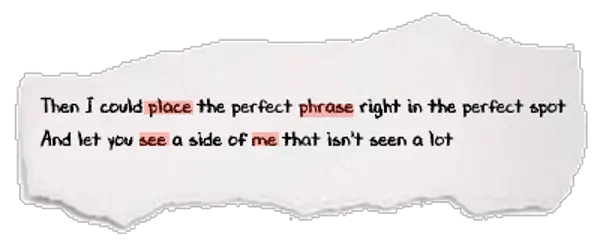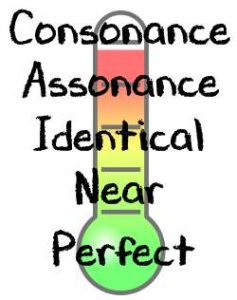Types of rhymes in songs include 1. perfect rhyme, 2. near rhyme, 3. internal rhyme, 4. identical rhyme, 5. consonance rhyme, and 6. assonance rhyme. Rhymes are one of the key elements of a song. They are what makes the song easier for us to remember. Rhymes in songs keep the song interesting and engaging. Choosing the right rhyme and rhyme scheme helps to create an interesting and easily remembered lyric.
Perfect Rhymes
A perfect rhyme is one where the sounds at the end of each word match exactly. “Dog, Log”, “Soap, Rope”, and “True, Blue” for example. Notice that the spelling of a word has nothing to do with which type of rhyme it is. It has everything to do with the sound the word makes.
So, although “soap” and “rope” given in the example above don’t contain the same ending letter sequence, they are still considered perfect rhymes just as much as “true” and “blue” are, which each end with “ue”.
The perfect rhyme is considered the strongest type of rhyme there is. Since the ending sounds of the words are identical (remember, spelling doesn’t matter), they create a perfect resolution to the ear.
Near Rhymes
I consider near rhymes to be something like “time-mind”, “can- lamb”, or “on-pond”. They have similar vowel sounds. Also known as “imperfect rhymes”, these are not as strong as perfect rhymes, but they are still close enough to each other in sound to be an effective rhyme.
Using near rhymes opens up so many possibilities for rhyming opportunities in songs. There are only so many perfect rhyme combinations and our ears are fairly used to hearing them, but near rhymes are available in such quantity that a very creative lyric rhyme can be crafted using this type of rhyme.
Internal Rhymes
Internal rhymes are words that rhyme with each other within a lyric line. These can be perfect rhymes or near rhymes. Below is an example of two internal rhymes from a song I wrote. The first line contains a near internal rhyme and the second line uses a perfect internal rhyme.

line 1 “place-phrase” (near rhyme)
line 2 “see-me” (perfect rhyme)
Internal Rhymes are an effective way to improve lyric flow, as long as it’s not overdone. Did you notice how the two lines as a whole used a perfect rhyme? (spot-lot)
Identical Rhymes
These are simply using the same word or word ending for each line. An example would be “tonight-night”, or “night-night”. Identical rhymes are not as strong as perfect or imperfect rhymes but they can still be used in a useful way when done right. An example of this is The Who’s song, “My Generation”.
Assonance Rhyme
An assonance rhyme is one where the words have the same vowel sound within them. Examples would be.
fame, lane, tape, crave
light, time, mind, vise
road, loan, toast, cope
This type of rhyme is weaker than the others, but still offers some unique combinations of words. Given the right melody, this can result in an interesting sounding rhyme,
Consonance Rhyme
This type of rhyme is considered the weakest. A consonant rhyme is where the words end with the same consonant sound. Examples would be.
truck, kick, tack, seek
tram, climb, some
switch, latch, much
Being the weakest type of rhyme, consonant rhymes should be considered as a last resort for using in your lyric.
To recap, I’m including an image below that represents the strength of each type of song rhymes. The strongest, or green level is the perfect rhyme.

Have you ever heard a song for the first time and were able to anticipate what the word at the end of a line would be? If so, it’s probably because of the previous line’s structure and how the writer set up the tension and led you along to the release. Consider the following lines..
The night is dark and the day is light (sets up a contrast)
The moon is dim and the sun is ___
You naturally are led to the word, “bright”. This is what I mean by the previous line setting up the next one. This is a simple example but gets the point across. If I had written..
Spring is here, how I love the rain
I finished that book that was all about ____
About what? Spain? Pain? Grain? Maine? A train? Not quite as obvious as the first example, is it?
The tension was established by ending the first line with “rain”. Your brain is assessing the context but is not drawn to a conclusion because the second line seems to have nothing to do with the first.
It is important to set up the context and then work on finding the right rhyming words to paint the picture that the listener is expecting to see.
Rhymes also help the listener remember the song once the pattern is planted in their brain. Rhyming sounds helped us to learn and remember the alphabet song when we were kids..
![]()
Those rhyming sounds of the letters effectively drilled into our head how the song went along. Those first five letters really set up what was going to be coming in the next sound patterns.
Let’s get this out of the way now..
Love and above..
Way too cliche! Unless you can find a unique and creative way to use these two words together as a rhyme, I suggest avoiding it. Dion & the Belmont’s used “above” at the end of the line preceding the title line, “Why must I be a teenager in love”
It worked back then, not so much now.
Rhyming Schemes
Rhyming schemes for songs refers to how you repeat the different types of rhymes in songs, or in the sections of your song. It’s common when learning about rhyme schemes to see ABAB, AABB, AAAB, or even some X’s listed such as AXAX, for example. An “X” represents a line ending with a word that does not rhyme with any other word in that section. All of these are to show how a rhyming scheme is used. For example, one of the first songs I wrote uses an AABB rhyme pattern. Here are the lyrics..
My First Song (Untitled)
When it gets to be that special time of year (A)
And everyone is full of Christmas cheer (A)
Think about the ones who won’t be coming home (B)
They’ll be spending Christmas somewhere all alone(B)
It’s for those people away from home I sing this song (A)
Cause it’s with their families that they belong (A)
May God bless and help you out along your way (B)
I hope you find all the happiness that comes with Christmas day (B)
As you can see, the first two lines of each verse end with the words rhyming with each other, (year,cheer) and (song,belong). and the last set of lines end with their own rhyme, (home, alone) and (way, day). AA pattern for lines one and two, and BB pattern for lines three and four of each verse.
Lets take a look at the first half of a verse of another song I wrote, (Love Shining Through). This one has an ABAB pattern.
3am, the baby’s cryin’ (A)
Up for the third time tonight (B)
You know mama won’t quit tryin'(A)
To make sure that her little girl’s alright (B)
Did you catch the two words that rhymed with each other in the last line? “Sure” and “her” make of internal rhyme which was discussed earlier in the article.
Now I want to move on and give an example of where the “X” plays a role in the rhyme scheme. Remember, an “X” means the line ends with a word that doesn’t rhyme with any other line in that section. Here is the second half of the first verse to “Love Shining Through”. The pattern is XCXC
Another sleepless night together (X)
And lately there’s been quite a few (C)
A soft lullaby, and whisper, “goodnight”(X)
That’s love shining through (C)
Here is another case where there is internal rhyme, (“lullaby” and “goodnight”)
By the time I sing these words in the verse the sound of the word “together” at the end of the first line is out of the listener’s ear memory. It is marked with an “X” because it doesn’t rhyme with any other line ending. The word “few” creates a tension that is released by landing on “through”. The internal rhyme sets up the transition from “few” to “through”, nicely.
I want to encourage you to study the terms and definitions of different types of rhymes in songwriting if that is what interests you. It could be helpful to you should you work with a co-writer who has that knowledge and is communicating things about song structure using those terms.
Now that you know what rhyming patterns are, I want to discuss the importance of keeping the pattern, once established in a section of the song, the same in other similar sections. In other words.. If you have an AABB pattern in verse 1, apply the same pattern to verse 2 as well as any subsequent verses.
The listener is going to expect that. You may or may not decide to keep that pattern in the choruses. Whatever rhyme scheme you do choose for the choruses should remain the same in all choruses. Sometimes a line might be worded slightly different in one chorus than it is in the rest of them, but the established pattern should remain the same. A bridge, which usually occurs once, can have whatever pattern you decide works best.
Another important point to bring up is to not have the same rhyming sounds occur across sections. For example, if you have an ABAB pattern applied to the verses and the “A” words in verse 1 are, “pay, day”, don’t have the “A” words in verse 2 be ones that end with that “ay” sound similar to “pay, day”. You should vary the sounds. This will provide the listener with a more pleasurable listen and they won’t even know why.
Think of it this way… if you go to someone’s house and notice the entire home painted the same color.. let’s say the siding is brown, the trim is brown, the walls inside are brown, the baseboard is brown… I’ll stop now, it’s already boring just reading, isn’t it?
Well, don’t put your listener through that. They don’t want to hear every rhyme sound the same. Mix it up and you’ll be far better off, believe me.
Final Thoughts
Rhymes in songs are such a powerful and necessary tool to use when crafting your songs. Study the lyrics of some of your favorite songs and notice which rhyme types the writer chose to include. Look at the rhyme scheme and how it was applied to the song’s lyric. There are online rhyming dictionaries that you can use to help find those words to use. Below are a few
Start applying these tips to your writing today! Thanks for reading and write on!
